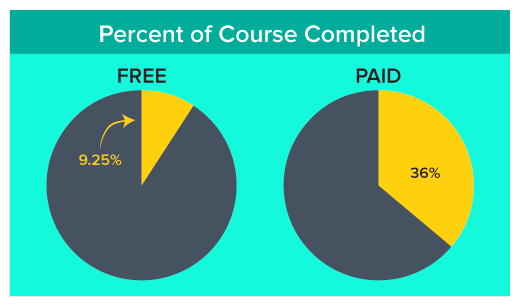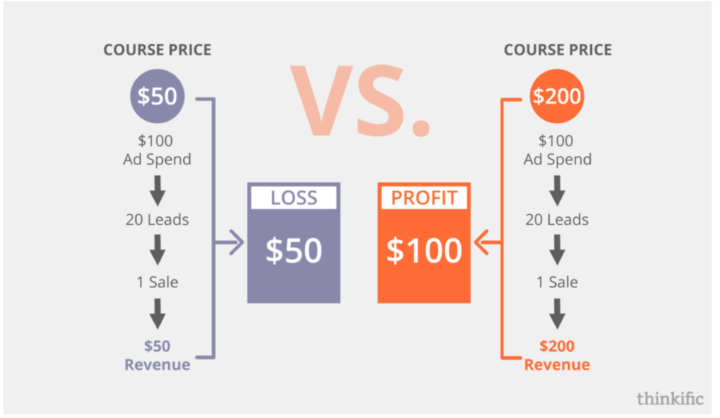How to Price Online Courses
If for many people the main challenge is to create online courses, for others the difficulty appears even when it comes to pricing online courses.
After all, how much worth a material that you created? How to put a price on your knowledge?

Pricing online courses: How much should I charge for my course?
You have made the decision to create an online course or are seriously considering doing so, but you are not sure how much money you can make from it.
Or maybe it’s already done and now there’s the question: how do you price online courses? How much should you charge? How much is your course worth?
To help with this issue which is common to the vast majority of people who want to sell something of their own, we’ve outlined a few simple steps that can help you to decide at once.
1. Understand the transformational value of your course
One of the main difficulties and barriers when it comes to pricing online courses is the idea that you are charging for your expertise, which can be really intimidating.
But something you should always keep in mind is that you are not just selling knowledge, you are selling a transformation (and if you’re not, you should!).
When a person enrolls in a course, either online or face-to-face, she seeks to acquire knowledge that will help her improve in some aspect of her personal or professional life, or both.
So the value added in a course is very high because you are not delivering something with expiration date, you are delivering something that can be tapped to achieve lasting results.
Let’s look at the following three course topics:
- 5 mindfulness meditation techniques to relieve stress and improve your quality of life
- How to get your first clients through social media
- Practical course to lose shame and speak well in public
Every one of these courses promises a potential transformation. They guide the student in a change, take him from a before to an after:
- Stressed > Relaxed
- No clients > With clients
- Feeling insecure to speak in public > Feeling confident to speak in public
Understanding this is understanding that your course is much more than the content you created.
There is much added value in this material and so you do not have to be afraid to price online courses, they are worth the investment.
– Step by Step to Create Online Courses
2. Realize how much this transformation worth
This is much easier to calculate if your transformation involves helping your students to make more money.
But even if you are simply teaching your students how to be more productive, get rid of stress or lose weight, for example, you should still put a price on it. After all, there is your knowledge and time invested there.
For example, how much would someone be willing to pay to:
- Feel more confident?
- Feel more beautiful and healthy?
- Spend less time working and more time with your family?
Yes, it is difficult to put a price on these transformations.
But the key here is that what you are teaching is important. It will change the lives of these people for the better, and they want that, they came to you.
So if you’ve created a course that will really lead to these results, you need to put a price on that, after all, we all need to get paid for our work.
– 7 Strategies to Create an Online Class Successful
And believe, the consumer himself distrusts the quality of what is offered for free or for a very low value.
Which brings us to the next point …
3. Do not be afraid to charge

When you charge less, students tend to underestimate the content of your course. Graph via ConvertKit.
When it comes to pricing online courses, we see courses of all values out there.
It is common to find courses up to free, but make no mistake, often the free course it’s only an “appetizer”, a module for the student to test and realize how valid is to take the course.
– Free online courses as a strategy to attract students
This is a very valid marketing strategy, especially for beginner instructors.
But back to the real value of your course, we suggest you start by asking the following question: Is the transformation you are delivering worth less than $ 100?
No, it’s worth more … so don’t sell yourself short! Do not be afraid to charge for what you know has value.
Charging less does not mean it will sell more. On the contrary, you are likely to face negative consequences, such as:
- Your students will not take the course seriously and will not put the time and effort they need. If you do not believe it, see the chart above for the difference in completion rates between a free and paid course.
- The value of your course will be perceived as lower than a course with a higher price.
- When you charge too little, you tend to attract buyers who are just looking for something to put on the resume and do not take learning seriously. These buyers are more likely to request reimbursements and to take up more time and energy than those who pay a higher price.
4. Think about how much you want to profit from your course
This is not the determining factor for pricing online courses, but it helps put things in perspective.
If your plan is to get the most of your income from sales from your course, how much money do you need to make to make it happen?
Or maybe you are not thinking about having your course as your only source of income, but only ensuring an extra income of $ 5,000 to $ 10,000 a year, for example.
It is important to be realistic in setting your goals. Let’s say your goal is to earn an extra $ 10,000 a year with your course. Your email list is 1000 people and you have a Facebook group of 500 members.
While you may be able to attract some students through other channels, you can count on most of your sales from your existing audience.
– How to Create a Successful Email Marketing Campaign
If you charge $ 20 for your course, it means you will have to sell it to around 500 people. With a current audience of 1,500, this translates into a conversion rate of 75%.
Only you know if this is possible, given your niche, audience and course topic, but overall, that conversion level is not realistic.
Now imagine the price of your course at $ 500. Charging this amount, you just need to sell your course to 20 people, a much more palpable goal.
Did you find it expensive? All right, find a middle ground and capitalize on the outreach campaign and the relationship with your existing audience.
Remember that in the digital age we live in, Content Marketing is a great ally of sales.
– Content Marketing to Sell Online Courses
5. Find out how much you need to charge to make a profit
Remember that after creating your course, you still need to dedicate time to marketing, customer service, creating updates, etc.
So in addition to the expenses you already had to create the course, be it with design, hosting platform, video recording equipment, etc. , you still have the costs of disclosure.
– Learn how to create professional-looking online courses
To know how much to charge to make a profit, start adding up all your expenses with creating and selling the course.
Another thing you need to understand, is that the effort required to market a course is independent of its price, the work is the same.
Think about how long it takes you to get a lead, nurture that lead, and convert it into a customer. It is an investment of much of your time, spent on advertising and, of course, a lot of work.
– Know what your buyer persona is looking for and attract leads
Make sure you factor it all together. You need to be able to advertise your course and your profit needs to exceed your advertising spend.
Check out this visual example of Thinkific:

6. Offer the ability to purchase additional resources
This is an interesting factor for pricing online courses, which few people take into consideration.
In the eagerness to offer the best course possible, many instructors deliver several extra materials to assist the study, for free.
It’s okay if this material did not cost you anything, but if it does, there’s no reason not to charge.
The more resources your course offers, the more value it delivers to the student, and one option is to let them choose whether they want to pay for it or not.
For example:
Start with a base price of $ 100.
Now, depending on what extra features you offer as part of your course, your price increases. Some of the bonuses you can offer include:
- Private weekly chats
- Downloadable workbooks
- Q&As
Each of these resources will mean more work on your part and more value to your students, so do not be afraid to include this in your price.
7. Define a billing structure
Once you have decided how much you will charge, there is still one final step to pricing online courses: define how you will structure this billing.
Will you offer a payment plan? This can mean breaking a course of $ 300 in monthly payments of $ 100.
Will you offer only one standard course option or different price levels? The price levels for a course can be a fee of $ 100 for the basic version, $ 150 for the standard version and $ 200 for the premium version.
Of course each level will have to provide an increase in content, which means more work for you, but also more money.
If your goal is to publish updates every month, you can also choose to create a monthly fee, and thereby ensure recurring income.
– Benefits of Recurring Payment for Online Courses
Think about it, the options for pricing online courses and securing a good extra income are numerous.
Online Courses Platform
Summarizing what we’ve learned so far: when pricing online courses, set the cost of your course based on the value you are providing and the transformation you are helping your students achieve.
After all, you are providing knowledge and an experience that only you can offer.
Course ready, it’s time to put it online and for this you will need an eLearning platform, also called Learning Management System.
– Whats is a Learning Management System
A LMS, as its name implies, is basically a SaaS (software as a service) that functions as an online classroom.
Through this platform, instructors can make their online classes available.
What’s more, an LMS has a number of features your business will need, such as integration with other content platforms and ways to get paid online.
Complete eLearning platform, Coursify.me is the ideal solution for anyone who wants to create, sell and advertise courses on the internet without having to invest to start their own business.
Serving businesses and professionals in more than 60 countries, the platform is a dynamic and customizable Learning Management System.
Coursify.me offers three plan options for you to decide which best suits your needs and the good news is that the Beginner Plan is free!
Visit our website, test the platform and start selling online courses right now.

